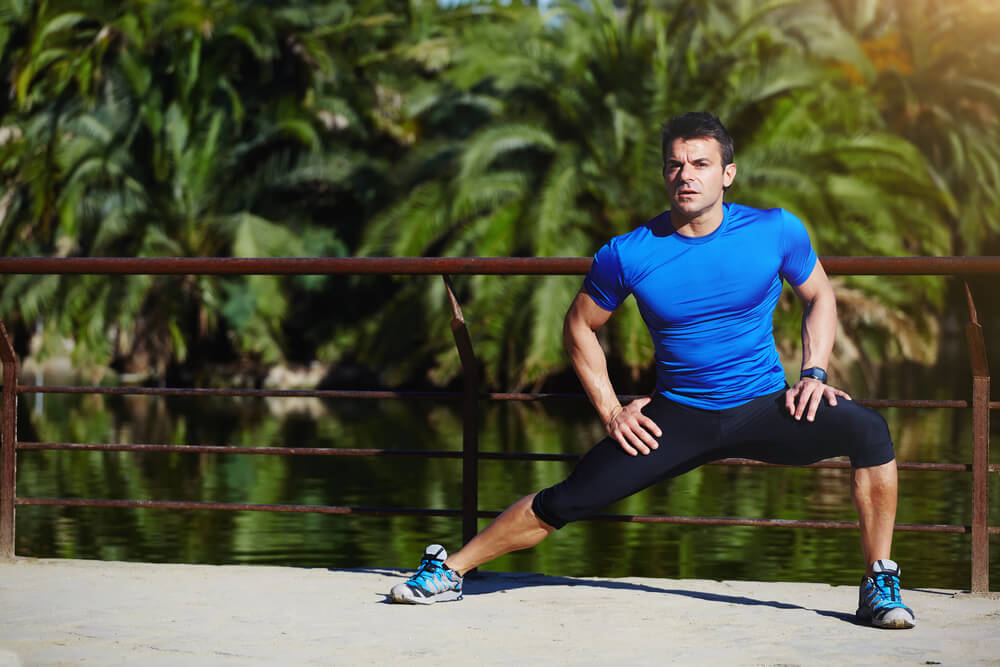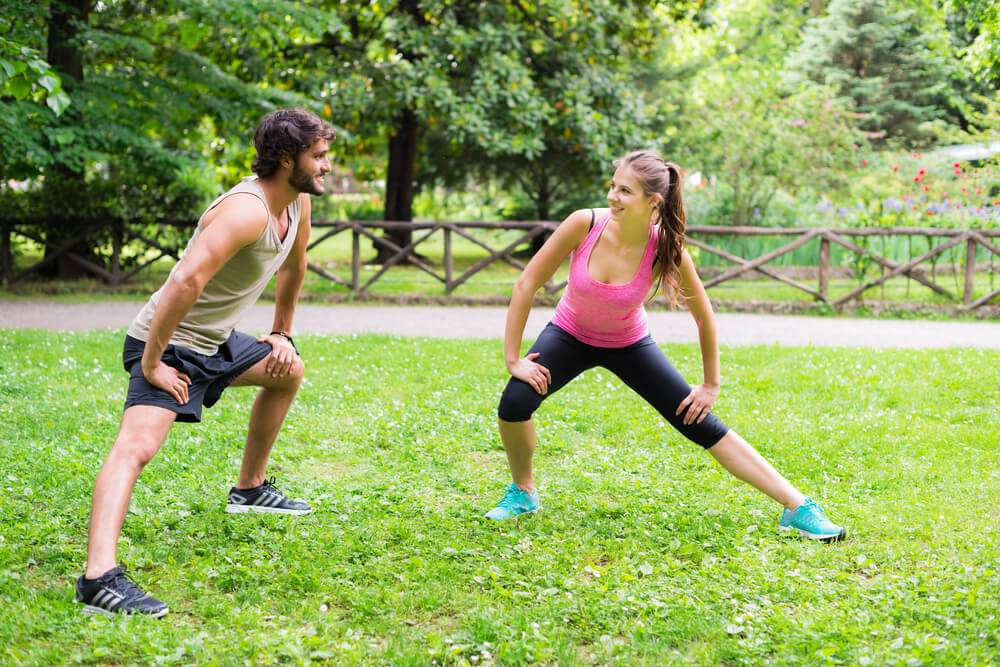
If you’re working out without stretching, you’re doing your body wrong! Hit these stretches and you’ll feel better and build more muscle in the process.
A regular workout routine is key to obtaining and maintaining a fit body. While many people hit the gym three or four times a week, they often fail to do the one thing that may prevent injury during training – stretching.
Healthcare professionals and personal trainers have long debated the need for stretching before a workout. But, studies have shown there are significant benefits to including it in your warm-up before tackling an intense training session.
Before beginning an intense workout, stretching can help prepare your mind as well as your body. Rituals, such as stretching, help get us in the right frame of mind. They let our body know what lies ahead. This is especially important if you’re training with weights because concentration and proper form are an important part of avoiding injuries.
Stretching promotes a sense of calm, releases muscle tension and gets our mind ready for the task ahead. The more you stretch, the more relaxed your muscles will be and injury is less likely.
This Is What Happens When You Stretch
When you stretch your body increases blood flow. The blood flows not only to your muscles, but also throughout your whole body. This is why you are less sore after working out when you stretch. Your blood also helps nourish your muscles, making your workout more effective.
Studies have also shown that people who stretch before training are more flexible than those who don’t because it increases the range of motion in the joints. This is especially important for those involved in sports that require supple muscles such as soccer or martial arts.
How Stretching Can Improve Performance And Limit Injuries
Now that you know why stretching is beneficial, let’s look at how you can use it to improve your performance and reduce injury. Proper technique and form are very important during stretching.
Performing stretching exercises incorrectly can actually increase the risk of joint injury and muscle tears. Stretch to the point of mild discomfort. Stop at the first sign of pain and never bounce as it can cause micro tears in the muscle. These tiny tears often prompt scar tissue to form, which reduces flexibility. That’s what you are trying to avoid with your stretching.
Concentrate solely on the body part you’re stretching. This will limit movement in other parts of your body. When you stretch, focus on large muscle groups such as calves, shoulders, thighs, back and neck. Always strive for symmetry and stretch both sides of your body to promote balance.
Yoga positions are a great way to use whole body movement during stretching. It is best to introduce new movements gradually to give your body time to get used to it. The American College of Sports Medicine (ACSM) recommends stretching at least three times a week before training, performing each stretch three to five times and holding it for a minimum of 10 seconds.
Never stretch to the point of sharp or intense pain. You should stop if you feel more than mild tugging or discomfort in your muscles. Learn to recognize the difference between discomfort and pain.
Some Basic Stretching Moves You Should Use And How To Do Them
While there are many different types of stretching exercises to choose from, there are a few basic moves that everyone should include in their warm-up. These will get you ready for just about anything.
The standing cat-camel stretch is good for warming up your entire back. To perform this move, stand upright with your knees slightly bent and your feet shoulder-width apart.
Slowly lean forward and place both hands on your knees, rounding your back. Check your form to be sure your shoulders are curving forward and your chest is in a closed position. Slowly open up your chest and roll back your shoulders. Repeat three to five times, holding the stretch for 10 to 30 seconds each time.
Neck stretches should be done slowly and carefully. The corner stretch is a great move to loosen up your cervical spine before getting down to serious business in the gym. Stand facing a corner with your feet together. Ideally, you should be about two feet back with your forearms placed on the wall and elbows slightly below shoulder height. Gently lean into the corner as far as possible without pain. Hold the move about 30 seconds and release. Perform this move three to five times for maximum benefits.
Don’t Neglect To Stretch Your Back!
When stretching your back, don’t forget your shoulder blades. The levator scapula stretch is perfect for flexibility and reducing neck pain and discomfort. Raise your elbow above your shoulder on the side and rest your elbow on the doorjamb elongating your levator scapula muscle. Next, turn your head in the opposite direction of the stretch and tuck in your chin.
You should feel a gentle stretch in the back of your neck. Place your fingers on the opposite hand on your head and gently pull your head forward to deepen the stretch. Hold for 30 seconds and repeat three to five times.
Performing shoulder stretches are an important way to ensure balance in the neck and back. Stretching your shoulders will also improve posture and reduce shoulder pain in the rotator cuff. Focusing on the supraspinatus muscle is one way to accomplish this goal. This muscle helps stabilize the shoulder joint during movement.
Grasp a hand towel in your left hand and throw it over your left shoulder. Then, grab the towel with your right hand behind your back. Pull the towel upward toward the ceiling, keeping your shoulder loose and your hand on the left side of your back. You should feel a gentle stretch in your shoulder, but not pain. Hold the position for 30 seconds and repeat on the other side. Try to do three to five sets each side.
A second stretch focuses on the infraspinatus and trapezius muscles. Sit in a chair with your back straight and raise your arm. Gently grasp your elbow and pull your arm across your chest until you feel a stretch in your middle back area. Hold for 30 seconds and repeat three to five times on each side.

You Should Also Stretch The Muscles In Your Chest
This move focuses on the pectoral muscles and is easy to perform. Lie on your back on a mat. Bend your knees and let your arms rest comfortably on the sides of your body.
Slowly pull your shoulder blades together until you feel them flatten to the mat and hold for 30 seconds. Let go and bring your elbows away from your sides slightly, letting them rest at about 90 degrees. Pull your shoulder blades together again and try to get them closer to the floor. Hold for 30 seconds.
Don’t Forget To Stretch Your Legs
Your legs can’t be ignored when you stretch, as you use these muscles a great deal during a workout. To stretch the front of your thigh or quadriceps muscle, lie on your side and rest on your bent elbow. Bend your leg, grasp your ankle and pull towards your butt until you feel a gentle stretch in the front of your thigh. Hold for 30 seconds and repeat three to five times on each leg.
During this exercise, it is important to avoid overstretching your quadriceps. Listen to your body and stop if you feel a sharp pain in the muscle.
The back of your thighs or hamstring muscles must also be stretched. These muscles are often tight and prone to injury if not properly warmed up before a workout. The seated hamstring stretch is a great way to accomplish this goal.
Sit on the floor with your legs stretched out in front of your body, spreading them apart about shoulder width to form a V. Flex your feet toward the ceiling and bent forward at the waist until you can touch both feet with your hands. Continue moving forward slightly until you can feel a gentle stretch in the back of your thighs. Hold for 30 seconds and repeat three to five times.
You can also stretch your hamstrings with a standing exercise if you prefer. Standing straight, step forward with your right foot and turn your toes on your left foot until they are pointing away from your body. Bend the left knee while straightening your right knee and bend forward slightly until you feel a stretch in the right thigh. Be sure to keep your back straight and your foot firmly planted on the floor. Proper form is essential during this move to avoid over stretching your hamstrings.

Runners Need To Pay Attention To Ankles
If you’re a runner or do a lot of weight bearing activities, you must stretch your ankles to avoid injury. A simple ankle pump is a fast and easy way to be sure your ankles are loose and ready for action.
Sit on the floor with your feet stretched in front of you and flex your feet toward the ceiling. Gently pump each ankle up and down for 10 reps on each side. Be sure to stretch your feet as far as you can without feeling pain.
You can also vary this move by sitting with your legs in front of your body and moving your feet in and out as long as you don’t feel sharp pain. Ankle circles are another great stretching exercise. To perform this move, sit in a chair with one leg stretched in front of your body. Move your foot in a circular motion 10 to 20 times on each foot.
The Often Forgotten Wrists Also Need Stretching
Chances are, you don’t stretch your wrists very often. But, you should. In particular, your wrists need a good stretch before a weightlifting session.
The prayer stretch is a great way to warm up your wrists prior to working out. Bring your hands together in front of your body with your palms touching as if in a prayer position, keeping them chest high and underneath your chin. Gently lower your hands toward the floor, keeping them in front of your stomach until you feel a gentle stretch in both wrists. Repeat 10 to 20 times to failure.
The wrist pump is also a way to stretch out your wrists. Simply make a fist and move your hands up and down using your wrist. Flex your wrists as far back toward your body as you can and lower. Repeat on each wrist 10 to 20 times until they feel loose and flexible.
Conclusion
Stretching is a great way to get your mind and body ready for a hard workout session. When you include these moves in your routine, you’ll have more energy during your workout and less muscle soreness.
While these exercises should be performed before your workout, you can stretch anytime to maintain flexibility. Most gyms have yoga classes that teach you how to hold a stretch along with breathing techniques that promote flexibility and calm the mind. This can be a great way to wind down after a hard workout or stressful day at the office.
Consistency is the key with any form of exercise, so be sure to perform your stretches before every workout to achieve maximum benefits. These moves may not be comfortable at first, but they will become second nature with time. As with any exercise, consult your physician before starting a stretching program if you have special health concerns or joint injuries. Always stay within your comfort zone and stop if you feel any sharp twinges of pain.
By Tony Henderson
Terry
Latest posts by Terry (see all)
- How Important Are Net Carbs For Building Huge Muscle? - Apr 28, 2017
- The Matt Damon Workout Explained - Apr 27, 2017
- Watercress – Benefits And The Best Way To Consume It - Apr 26, 2017











[…] you lost hope in developing your chest muscles? Have countless hours been spent to support chest training with only bleak […]
[…] you attempt to hit heavy weights without stretching your back you increase the chance of all sorts of back […]